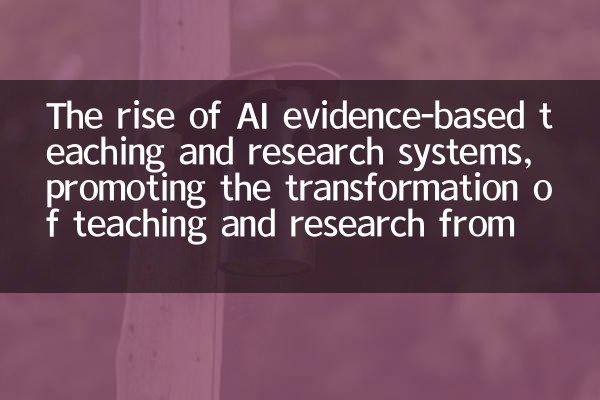The rise of AI evidence-based teaching and research systems, promoting the transformation of teaching and research from "experience-driven" to "data-driven"
In recent years, with the rapid development of artificial intelligence technology, the field of education has also ushered in unprecedented changes. The rise of AI evidence-based teaching and research systems is gradually changing the traditional teaching and research model and promoting the transformation of teaching and research work from "experience-driven" to "data-driven". This trend not only improves the scientificity and accuracy of teaching and research, but also provides educators with new tools and methods. The following will explore the specific manifestations and impact of this change through structured data and analysis.
1. The core functions of AI evidence-based teaching and research system

The AI evidence-based teaching and research system provides strong support for teaching and research through technologies such as big data analysis, machine learning and natural language processing. Here is a brief summary of its core functions:
| Function | describe | Application scenarios |
|---|---|---|
| Data acquisition and analysis | Automatically collect data on student homework, exams, classroom performance, etc. and conduct multi-dimensional analysis | Academic diagnosis and teaching effectiveness evaluation |
| Smart recommendation | Based on the data analysis results, recommend personalized teaching strategies and resources to teachers | Lesson preparation and teaching improvement |
| Evidence-based research | Through algorithms to mine the rules and associations in teaching data, generate evidence-based research reports | Teaching and research topic research and teaching reform |
| Real-time feedback | Provide real-time data feedback during the teaching process to help teachers adjust their teaching behavior | Classroom teaching, interactive management |
2. Data-driven teaching and research reform
Compared with the traditional "experience-driven" teaching and research model, the "data-driven" model brought by the AI evidence-based teaching and research system has significant advantages. Here is a comparison of the two:
| Contrast dimensions | Experience-driven teaching and research | Data-driven teaching and research |
|---|---|---|
| Decision-making basis | Teachers’ personal experience and intuition | Multidimensional data analysis results |
| Teaching and research efficiency | Long time, relying on labor | Automatic processing, efficiency improvement |
| Accuracy | Strong subjectivity, large error | Strong objectivity and high accuracy |
| Scope of application | Local and case studies | Large-scale and systematic research |
3. Practical cases and results
At present, many places in China have begun to pilot AI evidence-based teaching and research systems and have achieved remarkable results. The following are application data for some pilot areas:
| area | Application time | Effectiveness |
|---|---|---|
| Haidian District, Beijing | September 2022 to present | Teachers’ lesson preparation efficiency is improved by 40%, and students’ average grades are increased by 12%. |
| Pudong New District, Shanghai | January 2023 to present | The number of applications for teaching and research projects increased by 35%, and the project approval rate increased by 20%. |
| Shenzhen City, Guangdong Province | March 2023 to present | The frequency of classroom teaching interactions has increased by 50%, and the student participation has increased significantly |
4. Future prospects and challenges
Although the AI evidence-based teaching and research system has shown great potential, its promotion still faces some challenges. First, data security and privacy protection issues need to be taken seriously; second, teachers' data literacy and AI technology application capabilities need to be further improved; finally, the popularization of the system requires more policy support and financial investment.
Looking ahead, with the continuous maturity of technology and the deepening of application, AI evidence-based teaching and research systems will become an important infrastructure in the field of education. It can not only help teachers better understand students' needs, but also provide a scientific basis for educational decision-making and ultimately promote the overall improvement of educational quality.
In short, the transformation from "experience-driven" to "data-driven" marks a new era in teaching and research. This change is not only a technological advancement, but also an update of educational concepts, which will inject new vitality into the future development of education.

check the details

check the details